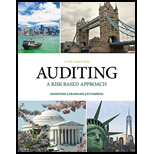
Auditing: A Risk Based-Approach (MindTap Course List)
11th Edition
ISBN: 9781337619455
Author: Karla M Johnstone, Audrey A. Gramling, Larry E. Rittenberg
Publisher: Cengage Learning
expand_more
expand_more
format_list_bulleted
Concept explainers
Question
Chapter 9, Problem 20CYBK
To determine
Introduction:
To select:
Choose the right option from the given options that fits best to the proposed statement.
Expert Solution & Answer
Want to see the full answer?
Check out a sample textbook solution
Students have asked these similar questions
Hello expert solve with accounting question
Hi expert please given correct answer with financial accounting
You are posting questions and giving unhelpful i am also positing you can give my answer i will not give unhelpful but If you unhelpful my answer then I will unhelpful your answer.
Also you know unhelpful will remove after coureshero review.
So coperate.
Chapter 9 Solutions
Auditing: A Risk Based-Approach (MindTap Course List)
Ch. 9 - In the revenue cycle, the most significant...Ch. 9 - Which of the following statements is true...Ch. 9 - Prob. 4CYBKCh. 9 - Prob. 7CYBKCh. 9 - Prob. 8CYBKCh. 9 - Prob. 9CYBKCh. 9 - Prob. 10CYBKCh. 9 - Prob. 11CYBKCh. 9 - Prob. 12CYBKCh. 9 - Prob. 13CYBK
Ch. 9 - Prob. 14CYBKCh. 9 - Prob. 15CYBKCh. 9 - Prob. 16CYBKCh. 9 - Prob. 17CYBKCh. 9 - Prob. 18CYBKCh. 9 - Which of the following statements is false...Ch. 9 - Prob. 20CYBKCh. 9 - Prob. 22CYBKCh. 9 - Prob. 23CYBKCh. 9 - Prob. 24CYBKCh. 9 - Prob. 25CYBKCh. 9 - Prob. 26CYBKCh. 9 - Prob. 27CYBKCh. 9 - Prob. 28CYBKCh. 9 - Prob. 29CYBKCh. 9 - Prob. 30CYBKCh. 9 - Prob. 31CYBKCh. 9 - Prob. 32CYBKCh. 9 - Refer to Exhibit 9.1. Which accounts are relevant...Ch. 9 - Prob. 2RQSCCh. 9 - Prob. 3RQSCCh. 9 - An important task ¡n the audit of the revenue...Ch. 9 - Prob. 5RQSCCh. 9 - Prob. 6RQSCCh. 9 - Prob. 7RQSCCh. 9 - Prob. 8RQSCCh. 9 - Prob. 9RQSCCh. 9 - Prob. 10RQSCCh. 9 - Prob. 11RQSCCh. 9 - Prob. 12RQSCCh. 9 - Prob. 13RQSCCh. 9 - Prob. 14RQSCCh. 9 - Prob. 15RQSCCh. 9 - Stainless Steel Specialties (SSS) is a...Ch. 9 - Prob. 17RQSCCh. 9 - Prob. 18RQSCCh. 9 - Prob. 19RQSCCh. 9 - Prob. 20RQSCCh. 9 - Prob. 21RQSCCh. 9 - Prob. 22RQSCCh. 9 - Prob. 23RQSCCh. 9 - Prob. 24RQSCCh. 9 - Prob. 25RQSCCh. 9 - Prob. 26RQSCCh. 9 - Prob. 27RQSCCh. 9 - Prob. 28RQSCCh. 9 - Prob. 29RQSCCh. 9 - Prob. 30RQSCCh. 9 - Prob. 31RQSCCh. 9 - Prob. 32RQSCCh. 9 - Prob. 33RQSCCh. 9 - Prob. 34RQSCCh. 9 - Prob. 35RQSCCh. 9 - Prob. 36RQSCCh. 9 - Prob. 37RQSCCh. 9 - Prob. 38RQSCCh. 9 - Prob. 39RQSCCh. 9 - Read the following scenario about Strang...Ch. 9 - Prob. 41RQSCCh. 9 - Prob. 42RQSCCh. 9 - ZYNGA (LO Z 3, 4, 5, 6, 8) Refer to the Why It...Ch. 9 - UTSTARCOM, INC. (LO 2, 3, 4, 5, 6, 8) UTStarcom is...Ch. 9 - Prob. 47FFCh. 9 - Prob. 48FFCh. 9 - Prob. 55DAUA
Knowledge Booster
Learn more about
Need a deep-dive on the concept behind this application? Look no further. Learn more about this topic, accounting and related others by exploring similar questions and additional content below.Similar questions
- Don't use ai given answer accountingarrow_forwardPlato Ventures reports sales revenue of $285,000 and the cost of goods sold is $163,000. What is the gross profit for the period? A) $112,000 B) $98,000 C) $122,000 D) $148,000. Please provide solutionarrow_forwardCorrect solution by best expert..arrow_forward
arrow_back_ios
SEE MORE QUESTIONS
arrow_forward_ios
Recommended textbooks for you
 Auditing: A Risk Based-Approach (MindTap Course L...AccountingISBN:9781337619455Author:Karla M Johnstone, Audrey A. Gramling, Larry E. RittenbergPublisher:Cengage Learning
Auditing: A Risk Based-Approach (MindTap Course L...AccountingISBN:9781337619455Author:Karla M Johnstone, Audrey A. Gramling, Larry E. RittenbergPublisher:Cengage Learning Auditing: A Risk Based-Approach to Conducting a Q...AccountingISBN:9781305080577Author:Karla M Johnstone, Audrey A. Gramling, Larry E. RittenbergPublisher:South-Western College Pub
Auditing: A Risk Based-Approach to Conducting a Q...AccountingISBN:9781305080577Author:Karla M Johnstone, Audrey A. Gramling, Larry E. RittenbergPublisher:South-Western College Pub

Auditing: A Risk Based-Approach (MindTap Course L...
Accounting
ISBN:9781337619455
Author:Karla M Johnstone, Audrey A. Gramling, Larry E. Rittenberg
Publisher:Cengage Learning

Auditing: A Risk Based-Approach to Conducting a Q...
Accounting
ISBN:9781305080577
Author:Karla M Johnstone, Audrey A. Gramling, Larry E. Rittenberg
Publisher:South-Western College Pub
